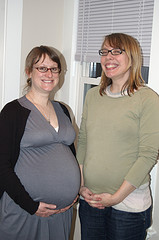A pregnancy is considered full term at forty weeks, so your estimated due date is calculated 40 weeks from the date of conception. Sadly, this system of calculation can lead to a somewhat inaccurate due date. One of the most common reasons for this due date likelihood of being erroneous is that many women do not have regular menstrual cycles. The pregnancy due date is calculated using an average menstrual cycle of every twenty eight days and the ovulation date being mid-cycle. For most women, this will simply mean that the estimated due date can be as much as a month off. It is important not to rely too much on the first due date that your health professional gives you. Many pregnancies, however, do not last for precisely 40 weeks. It is quite normal that the actual pregnancy due date is longer than this by up to two weeks.
A rough pregnancy due date is enough for most women to plan when they are going to file for maternity leave. Even if the due date isn’t entirely accurate, however, it can be used as a good indicator of when the women can decide to stop working. As the pregnancy progresses, the pregnancy due date can be estimated much more accurately by either an ultrasound scan or a blood test.

flickr.com/sundaykofax
A blood test can be used to know the amount of hCG a woman has in her blood, which can indicate how far along the pregnancy is and a due date. This test should result in a much more precise pregnancy due date than the one using a calculation based simply on the date of the woman’s last menstrual cycle. This date is often the first due date that a woman can, in fact, trust with regards to planning for the new arrival. This blood test, of course, cannot be done in the initial stages of a pregnancy as there is not enough hCG present.
An ultrasound scan is the most reliable method of determining a pregnancy due date. This is because babies develop at a somewhat uniform rate in the second trimester. The ultrasound technician will take pictures of the unborn baby and take a number of measurements required to estimate the due date. The pregnancy due date can then be estimated by the length of the fetus and the circumference of its head, as well as other points of reference. This pregnancy due date is likely to remain the same or differ only by a day or so as the pregnancy continues. Of course, the pregnancy due date is only a guide and more often than not, the baby will be born before or after the pregnancy due date instead of on the exact pregnancy due date that has been predicted.
Tagged with: fetus age • pregnancy due date
Filed under: Pregnancy